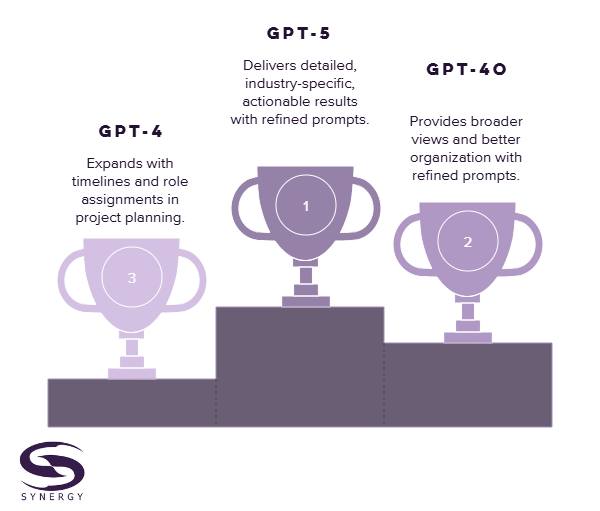It’s All About the Prompt, Part 2: Real-World Examples and GPT-4 vs GPT-5 Comparisons
- Synergy Team

- Aug 25
- 3 min read
Updated: Aug 27

In Part 1 of this series, we explored why prompting is such a critical skill and how GPT-5 changes the way we interact with AI. Now, we’re taking the next step—showing exactly how a well-crafted prompt can dramatically improve results.
In this post, we’ll walk through real-world examples, side-by-side comparisons with earlier GPT versions, and industry-specific use cases drawn from Synergy’s own experience helping clients put AI to work. For many first-time AI users, seeing the difference between a vague prompt and a refined one is the “aha” moment that makes everything click.
The Power of Refinement
A small change in how you frame a prompt can make a big difference in the quality of the output. Broad, generic instructions lead to broad, generic answers. Adding clear context, constraints, and a defined goal transforms the result from “helpful” to “immediately actionable.”
Example 1 – Cybersecurity
Cybersecurity is a perfect case for showing how precision changes the outcome.
Generic Prompt:
"Write about cybersecurity."
GPT-4o Result: A general, surface-level overview—useful for background reading but lacking depth or actionable steps.
GPT-5 Result: Slightly broader and better organized than GPT-4o, but still high-level without additional guidance.
Refined Prompt:
“You are a cybersecurity consultant advising a 200-employee manufacturing company. Write a detailed plan for improving phishing awareness, securing cloud accounts, and ensuring compliance with industry standards.”
GPT-5 Refined Result: A structured, targeted strategy complete with timelines, recommended tools, and draft policy language.
We see this shift all the time in our AI adoption workshops—specific, role-based prompts consistently produce results that are operationally ready.
Side-by-Side Prompt Evolution
With GPT-5’s extended context and model routing, you can layer in detail that earlier models couldn’t fully process.
Example 2 – Project Planning
Project planning is a common business scenario where richer prompts deliver dramatically stronger results.
Basic Prompt:
“Create a project plan for migrating to Microsoft 365.”
GPT-3.5: Produces a short, checklist-style plan.
GPT-4: Expands on the list with timelines and some role assignments.
GPT-5: Adds risk analysis, stakeholder communication strategies, and budget considerations.
Refined Prompt:
“Create a Microsoft 365 migration plan for a 500-employee organization in the financial sector, including risk mitigation, compliance requirements, user training strategies, and a phased rollout schedule.”
GPT-5 Refined Result: Delivers a detailed 12-week phased plan, with cross-team coordination steps, sample policy drafts, and adoption metrics.
For our clients, this level of specificity turns a generic plan into a blueprint they can put into action immediately.
Industry-Relevant Prompting
One of GPT-5’s greatest strengths is its ability to produce highly relevant, industry-specific guidance when given precise role and sector details.
Example 3 – Healthcare Compliance
Generic Prompt:
“How do I make my healthcare company compliant?”
Refined Prompt:
“Provide a HIPAA compliance checklist for a 50-clinic healthcare network, focusing on electronic records, staff training, and audit readiness.”
GPT-5 Refined Result: A tailored checklist with actionable steps, sample policy language, and a communication plan for staff.
By anchoring prompts in the realities of a specific industry, you not only get better answers—you get recommendations that match your compliance obligations, operational environment, and team capabilities.
Prompt Templates You Can Use

If you want to start refining your prompts today, these templates have consistently delivered strong results for Synergy’s clients across industries.
Role + Context + Task
“You are a [role] working in [industry]. Your goal is to [task]. Provide [format of output].”
Constraints + Deliverable
“Explain [topic] in under 500 words, using bullet points, and avoiding technical jargon.”
Comparative Analysis
“Compare [option A] and [option B] for [specific use case], including pros, cons, and a recommendation.”
Step-by-Step Process
“Outline a [process] for [goal], starting from [initial condition] to [desired outcome].”
Final Thoughts: experiment with prompt refining
Seeing is believing. Once you witness how refined prompts unlock GPT-5’s full capability, it becomes clear why prompting is the cornerstone of successful AI use.
In Part 1, we covered the theory behind prompting. Here in Part 2, we’ve shown how that theory plays out in real scenarios. In Part 3, we’ll explore advanced techniques like chained prompting, roleplay scenarios, and integrating GPT-5 into multi-step workflows for maximum efficiency.
In the meantime, try one of these prompt templates with your own use case and see how much closer you can get to the answers, strategies, and insights you actually need.





Comments